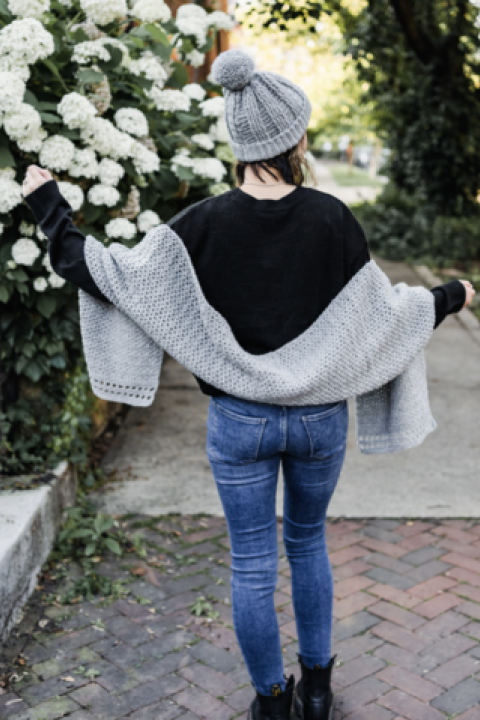It is with great pleasure that I invite my favorite Tunisian crochet designer, author, and dear friend, Dora Ohrenstein, as a guest author for this post. Please enjoy! – Toni L.
Where Did Tunisian Crochet Come From?
Curious minds are bound to wonder where Tunisian crochet originated. Is it related to Tunisia? And when did it first appear?
All great questions, but not as easy to answer as one might think. Textiles are studied and documented today by people trained in textile history, but that discipline is very new. In archeological digs of ancient sites, textiles were often misidentified as to the technique used to create them. That’s because the folks doing the digging had no training in what they were looking at when it came to textile construction.
Today it is widely accepted that knitting dates back to the first millennium in Egypt, and specimens of early knitting have made their way into museums around the world. Naturally, objects of such age and fragility are damaged and incomplete, but textile study has progressed to the point that these ancient textiles can clearly be identified as knitting or an earlier precursor to knitting called nålbinding.

But what about crochet? Has any ancient crochet been found? The answer is – no! While it is known that people used hooked tools to make socks and mittens in many places around the world, the concept of crochet as we know it today did not exist until the late 18th century. These earlier items were made with home-made tools, often a spoon with a hook added, and used slip stitches, but makers thought of this as a form of knitting. Slip stitching with a hook made it easier to work in the round to make mittens and booties.
19th Century Textiles: The Rise of Craft Publications and Middle-Class Domesticity
When we get to the textiles of the 19th century, scholarship becomes far easier due to the proliferation of printed books, pamphlets, magazines, newsletters, and the like. In many parts of the globe, the Industrial Age brought with it a larger middle class, along with the notion that women should rule over the home and generally remove themselves from the pesky matter of earning a living, at least for those whose incomes allowed. Women took up a variety of crafty pursuits with a vengeance, and clever craftswomen generated books and patterns to feed the frenzy.

The first crochet patterns appear in Britain in the 1840s and the patterns are quite basic, using only single crochet and based on colorwork designs for embroidery. Yet a number of gifted needlewomen developed crochet so rapidly that within 10 years, most of the stitches we know and love today can be found in patterns from the mid-19th century. Of course these needlewomen were subject to trends, fads and the fashions of their times, so however these unfolded, patterns were designed around them. At the time, lace, both to wear and to adorn home goods, was much in demand.
The Rise of Crochet: Innovation and Ornamentation in Victorian Times
Meanwhile, thin hooks used for tambour embroidery — which originated in the Far East and arrived in Europe during this needlecraft explosion — were just the tool these needlewomen needed to experiment further with this new craft of crochet and invent new techniques and stitches. Very quickly we have not just the slip stitch, but single and double crochet stitches! From there, the art of crochet expanded by leaps and bounds at an astounding pace, and crochet was used to make all kinds of items Victorians called “useful and ornamental” : capelets, muffetees (once known as “muffs” – anyone remember those?), bonnets, booties, as well as lap blankets, “couvre-pieds” (foot blankets) and lacy trims for cushions, lamps and almost anything in the home. The Victorians had opulent tastes!

The Evolution of Tools and the Birth of Tunisian Crochet in the 19th Century
Tools, obviously, are an important part of this history. We had knitting needles, we had crochet hooks – but what about a needle with a hook on one end? These were actually common in many parts of Europe and the Middle East, and knitters found the hook at the end useful in all sorts of ways. Then, suddenly in the late 1850s, needlewomen are discussing a brand new stitch that is midway between knitting and crochet and that, my friends, is when Tunisian crochet first appeared.
It was not called that. The first pattern, published by Mathilde Pullan in 1858 in The Lady’s Manual of Fancy Work, introduced the stitch as Princess Frederick William stitch, celebrating the marriage of one of Queen Victoria’s daughters to Frederick William, a Prussian prince. Here’s her introduction:
“We have great pleasure in presenting our readers with something that will, we are assured, be particularly welcome to them all – a new stitch in crochet; which will be found on trial at once very pretty, and very easy of execution.”
The stitch is, in fact, what we now call Tunisian simple stitch, and Mrs. Pullan’s design is for an opera cloak. The name Princess Federick William stitch was among many names for the new craft; others were Railway stitch, Tricot crochet, Tunisian crochet, and Idiot stitch, the latter apparently, because it was both easy and addictive.

Two of the leading British needlewomen of the time were Cornelia Mee and Madame Riego de la Branchardiere, both designers of countless pattern booklets. The obsession with Idiot Stitch spurred both to publish patterns based on this new craft. New stitches were soon invented. They called the craft Tricot Crochet, tricot being the French word for knitting, but here designating a type of crochet that resembles knitting.
This last point is really key to understanding the development of Tunisian crochet that began almost two centuries ago: it is a hybrid between knitting and crochet. Where up to that point crochet was associated with lace, Long-Hook crochet, as it was sometimes called, produced a thick, warm fabric suitable for blankets, scarves, capelets and the like. Mlle Riego made an entire book of winter wearables, all using Tunisian Simple Stitch.
Exploring the Origins: The Elusive Connection Between Tunisian Crochet and Tunisia
As to the connection with the land of Tunisia, it seems highly unlikely. Northern Africa in the 19th century was a multicultural society where many needle arts were practiced, and also a very traditional one, where crafts were passed down through generations without the need for books. And so, without documentation or museum samples, which do not exist, it’s hard to make a case for its origins there.
What we do know is that these 19th century names for crafts were invented for the purpose of marketing, not accuracy. A new stitch that is associated with an exotic location that most people knew little about was just the thing to attract the needle enthusiast looking for something exciting and different.
Much more can be said about Tunisian crochet as it continued to evolve in the twentieth century and in our own. We hope to have the opportunity to share more of it in future articles.

To further explore the roots of crochet and Tunisian crochet, consider delving into archived documents available at the Library of Congress.







So fascinating to read about crochet and Tunisian crochet history. Would make a great video as well! Thank you for sharing.
When did Tunisian as a term come into play? I find the variations on crochet terms over time fascinating and am curious if there was a reason it became a trendy term (and finally stuck) when it did. Madame Riego de la Branchardiere made an early go at calling this technique Scottish Knitting (Tricot écossais) in 1860, which has me wondering if the idea of it being Scottish had more appeal to the French than it did with English readers and that was why it didn’t last? Google Books has Tricot écossais (in English, despite the French name) and while it does have a Tartan pattern, it also features a couple of Alhambra patterns that definitely aren’t Scottish references.
Thanks for a really interesting post!
Love the insight you offer here – the history of this technique is so varied, it’s like a spider web! From the research I’ve done, the term Tunisian crochet first surfaced in English publications in the early 1900’s. When the technique popped up more in the 2000’s, the term Tunisian crochet took hold in the US, edging out “afghan stitch”, considering that the technique encompasses more than just one stitch. The more you know!! 🙂
Enjoyed the history of crochet and Tunisian crochet. I didn’t realize that crochet was the “new kid on the block” compared to knitting! Thanks for the article.
Great read! I’ve always wondered about the origins of Tunisian crochet.
This history of Tunisian crochet post was fascinating. I’ve always wondered where the name originated. I haven’t ventured into Tunisian crochet yet but have marked a number of patterns that keep calling my name. Now I am really motivated to learn the stitches. Thanks for your work in putting this together. I look forward to more such articles!
I have been hooked by Tunisian crochet for a while and have made several pieces so far. There is not a huge selection of patterns so I was so glad when a local knitting shop had a lady there who “introduced” me to your book and website. I just started an afghan to learn different stitches for each block – this helps me learn the stitches.